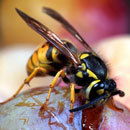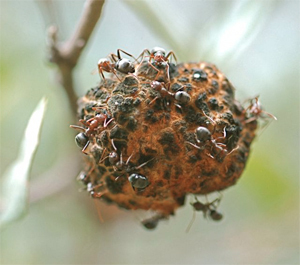5 Disturbing Ways Insects Can 'Hack' Nature

Nature is a giant computer: a vast mechanism of endless complexity and variety. It calculates, compiles, evolves -- and, of course, it renders genitals in exquisite detail. But if Hollywood has taught us anything about computers, it's that they will all be hacked by unreasonably attractive nerds. Sometimes while rollerblading. Nature has its hackers, too: At this very instant they're out there, cracking the most primeval codes in existence. But they don't hack machines. They hack lives.
Man, that was a good tagline. Somebody get on the Murder-hackers script while we write this stuff about crazy bugs, would you?
Malaria Hacks Your Body Odor to Make You Delicious to Bloodsuckers

Malaria is one of the biggest killers in Africa. It is an unholy bastard of a disease, caused by a parasitic protozoa transmitted through mosquitoes, and, oh yeah ... it causes your blood to explode. Your red blood cells, your very life essence, literally detonate in your veins as this deadly parasite multiplies inside of them until they burst. But on the plus side, it also makes you smell pretty awesome.
On the minus side, you only smell awesome to bloodsucking insects.

The marinading process.
When the malaria protozoa is ready to reproduce and move on from its host, it calls for an airlift to a new location, which it accomplishes by making you smell like a barbecue dinner with all the fixin's to a mosquito. Studies show that people infected with malaria are substantially more attractive to mosquitoes than people without it. Even weirder, people with transmittable malaria are more attractive than people with the non-transmittable phase. The contagious strain is specifically more delicious smelling to mosquitoes, which is astounding when you consider that malaria kills them, too. That's right: Those annoying little blood suckers aren't immune to the effects of the disease. If you think malaria sucks for you, imagine if your absolute favorite meal was fucking malaria.

Maybe with a white wine vinaigrette, some caramelized onions ...
Gall Wasps Reprogram Oak Trees to Build Themselves Guarded Fortresses
Gall wasps lays their eggs inside of oak blossoms, which seems like a real dumb idea. What a dumb, dumb wasp. That flower is going to change into an acorn, dummy! Go back to Wasp College.
At best, the baby should be pushed out; at worst, it'll be smothered and crushed inside of a slowly forming wood-nut, right? That's a bad way to go. It is, at the very least, embarrassing for the parents to explain. "I left my baby in a tree until the tree grew around him and killed him. How could I have known?!"

"Now he's an alien freak corpse! Man, fuck parenting!"
But the gall wasp larva can take care of itself: It has a battery of weapons that allow it to chemically hack oak trees and reshape their very nature. These baby wasps give off a substance that radically alters the development of the acorn, forcing it to grow a "gall" -- which is basically a house designed specifically for the squatting insect to live in for the rest of the year. It'd be like your shitty college friend showing up at your doorstep and doing something to your brain that forced you to build him his own room, rather than crash on your couch. Man, fuck you, Doug. Go stay at the Y.
Ah, but it's not all Wasp-Nintendo and Wasp-cereal in their Wasp-bathrobes. There are other, parasitoid wasps -- wasps equipped with literal, metal-tipped drills on their hindquarters -- that can burrow through even the hardened woody shell of a gall to get to the gall larva. If left unprotected, gall larva can end up becoming the hosts of still other, even jerkier wasps. Provided, of course, that the invader can get past the last line of defense built into the gall: bodyguard ants. The outside of the mutated acorn gives off a sweet honeydew that attracts ants who will, naturally, defend their food source. So the gall wasp larva doesn't just trick something into building it a fortress -- it hires mercenaries to patrol the walls.

In 10 years, those things will learn how to make guns, and then we're all fucked.
Baculovirus Hijacks Caterpillars, Turns Them into Parasitic Rainfall

The baculovirus sounds like a chrono-STD you get from boning the guy from Quantum Leap. But in reality, it's closer to the plot of the Alien movies: The baculovirus infects gypsy moth caterpillars (who are kind of pests anyway, so do try to keep that in mind when we tell you what happens to the poor lil' guys), then makes them climb to the top of the canopy and hang upside down. Which ... hey, is pretty much all right with the caterpillars? If an alien virus hacked your brain and forced you to sit on your couch and watch every episode of Three's Company back to back, you probably wouldn't mind it so much. You were going to do that anyway. The caterpillar is doing pretty good so far. Ah, but the baculovirus isn't done yet: After it maneuvers its host into a good position high up, suspended upside down ... they make it rain.

Not our fault. You should know by now to never read Cracked while eating breakfast.
The baculovirus causes the caterpillars that it infects to liquefy. It's a disease that turns baby moths into drippy death pudding. The virus uses up just about every part of the caterpillar to reproduce, then they start making enzymes which liquefy the caterpillar. The infected puddle-formerly-known-as-caterpillar drips down on other caterpillars, infecting them, too. It would be awful to behold, if we didn't want those bastard gypsy moths dead, anyway. Mostly this disease spreads by human means, in that we friggin' spray it onto them as insecticide.

"Of course the same virus wouldn't work on humans. We'd have to modify it slightly."
That's right: We were the sinister corporate shill trying to infect Ripley all along.
Vesparum Burrows into and Manually Steers Wasps Around Like Little Airplanes

At least the wasps seem to be locked into a firm karmic payback system. For every living being they horrifyingly hijack, something else body-jacks them. For example, when European paper wasps run into the Xenos vesparum bug, they abandon their entire society and live out the rest of their lives alone, as slaves to a malevolent entity that will use them as both home and transport vessel. Basically, think Starship Enterprise, only manned by a single crew member, living, and, of course, a wasp. This analogy got away from us a little, we admit. But in our defense, we were just a little bit terror-hypnotized by this:

Hubert Polacek, the man who took this photo, has balls the size of planets.
X. Vesparum hops on passing wasps and burrows into their abdomen. Once inside, these "taken" insects abandon their caste, their very genetic programming, and become antisocial loners. The parasite grows in size until at some pre-appointed time, all the infected wasps converge at once. How they all know where to go, what time, and exactly how X. vesparum manages to command the wasp to go there is a mystery. X-Men-like psychic powers is our best guess (our best guesses aren't usually very good). Regardless, everyone pulls up in their tricked-out, low-riding wasp ride and begin the mating process. The males hop out of their whips (which soon die because of the gaping hole in their sides) and begin mounting the ladies. The females never leave their victim-ships; they just waggle their genitals out of the hole they tore in their living vehicle's body and get to boning. Ha ha, ain't that just like a lady, fellas?*
*We exclusively know terrifying, terrifying women.

This is what porn looks like in hell.
When the deed is done, the females command their zombie steeds to head out and fatten up. These possessed wasps, freshly laid and feelin' pretty, decide they should be treated like the queens they feel they are inside. Deep inside. Where the parasite lives. So they fly off to a queen site and spend the winter sleeping next to other queens. Then, come spring, they head out to deposit more mind-controlling parasite larva under leaves. Or they just dump a load of them in their home nest, if they're feeling lazy. And they probably are, since living in a constant sci-fi horror movie seems pretty exhausting.
Ichneumon Wasp Create Artificial Riots to Conceal Their Heists

Many creatures, like that aforementioned spoiled Joffrey of the insect world, the gall wasp, try to sucker ants into protecting them. The caterpillar of the alcon blue butterfly does the same: By tricking ants into thinking they're ant larvae, the alcon gains the protection of an entire hive of fanatic soldiers. Which means these larvae must be in the safest nursery ever. What kind of lunatic bug would be willing to fight their way into the heart of a veritable army base to get at these grubs?
The Ichneumon wasp: The Joker to the insect world's Gotham City.

Minus the ridiculous nurse disguise.
The wasp needs the alcon caterpillars to lay its eggs in. But it faces two problems in doing this: First, it has to find out which anthills have the caterpillars. Second, it has to get to its squishy victims. Luckily, Ichneumon wasps have no trouble sniffing out the alcons, which is pretty impressive when you consider that these caterpillars make their literal living by smelling just like ant larvae. If the ants themselves could tell the difference, they'd tear the alcon apart. But Ichneumon wasps pass the larval Pepsi Challenge with flying colors.
Next, Ichneumon has to penetrate what is perhaps the greatest fortress in the insect world. Sure, the wasp is bigger than a single ant, but it's outnumbered, underground, and on the ant's home turf. Plus, its target is being kept in the nursery, arguably the most well-guarded room in the whole hive. It's like Ocean's Eleven for insects. How do you slip past hundreds of ants and then keep them occupied long enough to molest a few caterpillars? With an ingenious plan, a bit of chemical warfare, and big, waspy balls.
The alcon isn't the only one that can manipulate ants. In that video, you can see the Ichneumon wasp charge into the hill and immediately start getting its ass handed to it. But then it sprays a special pheromone that makes the ants go kill-crazy. The confused ants stop attacking the wasp entirely and turn on each other: It's the ant Rage Virus. Under the cover of this riot, the Ichneumon does its terrible business. By implanting its own larva inside the alcon, it, too, tricks the ants into protecting its brood. Eventually they both hatch -- the un-implanted caterpillars turn into butterflies, and the implanted turn into wasps -- and ditch their foster parents. Presumably while giving the finger to the whole colony on the way out.
Man, look how many wasps are on this list. We don't want to say anything controversial here, but it sure sounds like wasps might be kinda dicks, huh?
